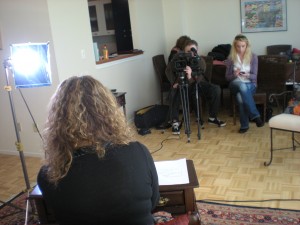Beyond the Classroom: Brandeis University’s Pioneering Video Lectures
Revolutionizing Education: The Rise of Video Lectures at Brandeis University

In an era where technology is reshaping every aspect of our lives, Brandeis University is at the forefront of educational innovation.
Professor Vardit Ringwald, Director of the Hebrew and Arabic Languages program, is leading the charge with cutting-edge video lectures that are transforming the traditional classroom experience.
This groundbreaking approach not only offers students unprecedented flexibility but also opens doors to a more accessible and inclusive educational landscape.
As we delve into this revolutionary teaching method, we’ll explore how Brandeis is setting new standards for higher education in the digital age.
Table of Contents
SVG Crew Takes Learning On Location
The SVG crew was on-site, capturing Professor Ringwald’s engaging lecture series, demonstrating how video technology is making education more adaptable than ever before.
This innovative approach allows students the flexibility to engage with their studies on their own terms, pausing and resuming lectures as their schedules permit. This flexibility is crucial for students who balance academics with other responsibilities such as work or family.
The Advantages of Video-Assisted Learning
While video lectures can’t completely replicate the interactive dynamics of traditional classroom experiences, they serve as a vital supplement, especially for students facing long commutes or financial constraints that might otherwise hinder their educational pursuits.
In an era where the costs of higher education continue to soar, the ability to access learning remotely is not just a convenience; it’s a game changer.
Democratizing Education Through Online Learning
Institutions like MIT and Yale are leading by example, offering numerous courses online at no cost, providing global access to world-class education.
This movement towards open educational resources is crucial in a society where knowledge is power and education is increasingly commoditized.
Expanding Horizons with Open Access to Knowledge
As America continues to navigate its place on the global stage, the democratization of knowledge through video lectures is more than just an educational trend; it’s a necessary evolution.
By providing free and flexible learning opportunities, universities are playing a pivotal role in equipping future generations with the knowledge needed to lead and innovate.
Frequently Asked Questions
How do video lectures benefit students with busy schedules?
Video lectures offer unparalleled flexibility for students juggling multiple responsibilities.
Unlike traditional classes with fixed schedules, video lectures allow students to engage with course material at their own pace and convenience. This means a working parent can watch lectures after putting children to bed, or a student with a part-time job can fit their studies around work hours.
Additionally, the ability to pause, rewind, and re-watch content ensures that complex topics can be revisited as needed, enhancing comprehension and retention. This flexibility not only reduces stress but also enables a wider range of students to pursue higher education without sacrificing other important aspects of their lives.
Can video lectures replace in-person classroom experiences?
While video lectures offer many advantages, they are not intended to entirely replace in-person classroom experiences.
Rather, they serve as a powerful complement to traditional teaching methods. Video lectures excel at delivering content and explanations, but they may lack the immediate interaction and spontaneous discussions that occur in physical classrooms.
However, many institutions, including Brandeis, are exploring hybrid models that combine video lectures with in-person or virtual discussion sessions.
This approach aims to harness the best of both worlds: the flexibility and accessibility of video content alongside the engaging, real-time interactions of traditional classroom settings. The goal is to create a more holistic and adaptable learning environment that caters to diverse student needs and learning styles.
How are video lectures contributing to the democratization of education?
Video lectures are playing a crucial role in democratizing education by breaking down geographical and financial barriers.
By making high-quality educational content available online, often for free, universities are extending their reach far beyond their physical campuses. This means that a student in a remote village can potentially access lectures from world-renowned professors at prestigious institutions.
Furthermore, the reduced costs associated with online learning can make higher education more affordable and accessible to a broader range of students.
This democratization of knowledge has the potential to level the playing field, providing opportunities for intellectual growth and career advancement to individuals who might otherwise be excluded from traditional higher education systems.
What technological challenges do universities face when implementing video lecture programs?
Implementing a successful video lecture program requires overcoming several technological hurdles.
Universities must invest in high-quality recording equipment and editing software to ensure that the video content is clear, engaging, and professional. They also need robust online platforms capable of hosting and streaming large video files without buffering or quality issues.
Ensuring cybersecurity and protecting intellectual property are additional concerns when distributing educational content online. Moreover, universities must provide technical support for both faculty creating the content and students accessing it, which may involve training programs and help desk services.
Despite these challenges, many institutions find that the benefits of reaching a wider audience and offering more flexible learning options outweigh the initial technological investments.
How might video lectures evolve in the future of higher education?
The future of video lectures in higher education is likely to be shaped by emerging technologies and changing pedagogical approaches.
We may see increased integration of interactive elements, such as embedded quizzes or choose-your-own-adventure style branching narratives, to enhance engagement and personalize learning experiences.
Virtual and augmented reality technologies could transform video lectures into immersive experiences, allowing students to virtually “step into” historical events or complex scientific concepts.
Artificial intelligence might be employed to create adaptive learning paths, adjusting the content and pace of video lectures based on individual student performance and preferences.
Additionally, we may see greater collaboration between institutions to create shared video lecture libraries, further expanding access to diverse educational resources.
As these technologies evolve, video lectures will likely become an even more integral and sophisticated part of the higher education landscape.
Share:
Search our blog:
Follow us on:
